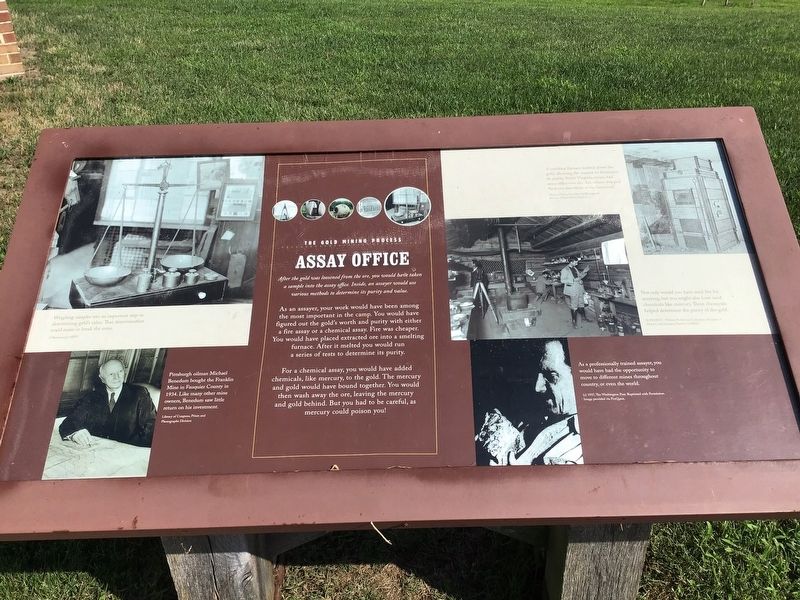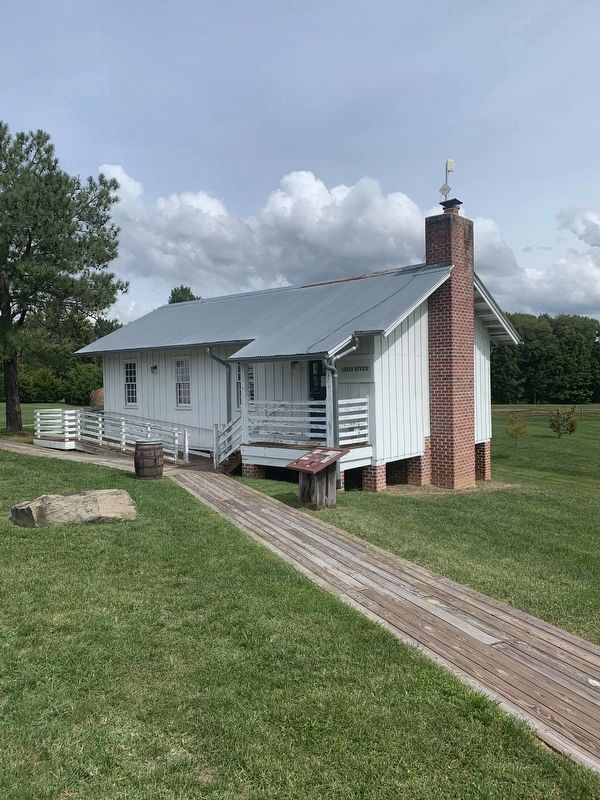Goldvein in Fauquier County, Virginia — The American South (Mid-Atlantic)
Assay Office
The Gold Mining Process
After the gold was loosened from the ore, you would have taken a sample into the assay office. Inside, an assay would use various methods to determine its purity and value.
As an assayer, your work would have been among the most important in the camp. You would have figured out the gold’s worth and purity with either a fire assay or a chemical assay. Fire was cheaper. You would have placed extracted ore into a smelting furnace. After it melted you would run a series of tests to determine its purity.
For a chemical assay, you would have added chemicals, like mercury, to the gold. The mercury and gold would have bound together. You would then wash away the ore, leaving the mercury and gold behind. But had to be careful, as mercury could poison you!
(captions)
Weighing samples was the most important step in determining gold’s value. That detemingation could make or break the mine.
Pittsburg oilman Micheal Benedum bought the Franklin Mine in Fauquiler County in 1934. Like many other mine owners, Benedum saw little return on his investment.
Library of Congress, Prints and Photographs Division
A smelting furnace melted down the gold, allowing the assayer to determine it’s purity. Some Virginia mines had assay offices on site, but others shipped their ore elsewhere to be processed.
Library of Congress, Prints & Photographs Division, FSA/OWI Collection
Not only would you have used fire for assaying, but you might also have used chemicals like mercury. These chemicals helped determine the purity of the gold.
PEMCO - Webster & Stevens Collection, Museum of History and Industry, Seattle/CORBIS
As a professionally trained assayer, you would have had the opportunity to move to different mines throughout country, or even the world.
1937, The Washington Post. Reprinted with Permission. Image provided by ProQuest.
Topics. This historical marker is listed in this topic list: Industry & Commerce.
Location. 38° 26.838′ N, 77° 39.324′ W. Marker is in Goldvein, Virginia, in Fauquier County. Marker can be reached from the intersection of Gold Dust Parkway and Rock Run Road (County Route 615), on the left when traveling east. Located at the Gold Mining Camp Museum at Monroe Park. Touch for map. Marker is at or near this postal address: 14421 Gold Dust Pkwy, Goldvein VA 22720, United States of America. Touch for directions.
Other nearby markers. At least 8 other markers are within 6 miles of this marker, measured as the crow flies. Hornet Balls (a few steps from this marker); Mess Hall (within shouting distance of this marker); Welcome to the Gold Mining Camp Museum (within shouting distance of this marker); Monroe Park (about 300 feet away, measured in a direct line); Goldvein (approx. 0.2 miles away); John Lederer and Party (approx. 5.2 miles away); Gold Mining in Stafford County (approx. 5˝ miles away); A Road from Yesteryear (approx. 5.7 miles away). Touch for a list and map of all markers in Goldvein.
Also see . . . Gold Mining Camp Museum - Fauquier County Recreation & Parks. The Official Gold Mining Interpretive Center for the Commonwealth of Virginia. (Submitted on April 28, 2022.)
Credits. This page was last revised on September 25, 2023. It was originally submitted on April 27, 2022, by Andre Malique Hicks of Whitakers, North Carolina. This page has been viewed 91 times since then and 17 times this year. Photos: 1. submitted on April 27, 2022, by Andre Malique Hicks of Whitakers, North Carolina. 2. submitted on September 23, 2023, by John Kilday of Warrenton, Virginia. • Bernard Fisher was the editor who published this page.

